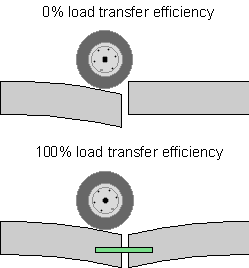Load Transfer
Each type of joint provides a different ability to transfer load across slabs. This ability is termed load transfer efficiency (or effectiveness). It is determined as shown in the figure. Note how both sides of the joint deflect evenly at 100% load transfer efficiency.
Load transfer is important to pavement longevity. Most performance problems with concrete pavement are a result of poorly performing joints. Distress, such as faulting, pumping and corner breaks occur in-part from joints with poor load transfer efficiency. All of these problems worsen when joints deflect greatly under loads. |

|
Dowel bars provide a mechanical connection between slabs without restricting horizontal joint movement. They also keep slabs in horizontal and vertical alignment. When loaded by heavy vehicles, dowel bars lower joint deflection and stress in the concrete slab and reduce the potential for joint problems by increasing load transfer efficiency.
The use of dowel bars (smooth round bars) in transverse contraction joints primarily depends upon the roadway or street classification and can be determined by slab thickness. Doweled contraction joints are not usually used in light residential, residential, or secondary urban pavements, but they are used in industrial roads, major streets, highways and airports that will carry heavy vehicles for long periods. Click here to find out when to use dowels.
When dowels are not used, joints depend solely upon aggregate interlock for load transfer. Aggregate interlock is the mechanical locking which forms between the fractured surfaces along the crack below the joint saw cut. Reliance on aggregate interlock without dowels is accptable on low-volume and secondary road systems where truck traffic is low and slabs are less than 8 inches thick. Ordinarily, transverse joints with dowel bars provide better load transfer than those relying strictly on aggregate interlock.

Aggregate Interlock |
Deformed steel tiebars are used in longitudinal joints primarily to prevent lanes from separating. Also by holding slabs tightly together, they promote aggregate interlock and consequently load transfer. |
To learn more, follow:
|


